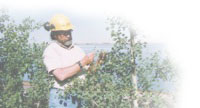 |
| site
design and hosting: pg advertising and design [sudbury] |
| Following a recommendation from the Ministry of Environment to assess the level of metals found in Sudbury-area soil, a working group called the Sudbury Soils Public Liaison Committee held its first meeting on August 1st, 2001. Membership included the Sudbury & District Health Unit, Ministry of the Environment, City of Greater Sudbury, Inco Limited, and Falconbridge Limited.
The committee was given the responsibility to review the ecological and human health implications from elevated soil levels of nickel, copper, cobalt, and arsenic identified in some locations within the Sudbury area. The metals had been recognized in a 2001 ministry report, which summarized various soil studies completed from 1971 to 2000. No Human Health Risk Expected Although agreeing that there was a need for further investigation and assessment, both the ministry and local Medical Officer of Health agreed that, based on previous studies of a similar nature in other Ontario communities, "there is no expected immediate risk to human health". To provide the extensive number of soil samples required for the risk assessments, the Ministry of the Environment, Inco Limited and Falconbridge Limited initiated a sampling program across the region throughout the summer and fall of 2001. Additional specimens were taken in places where people gather and children play, such as residential areas, public parks and beaches, schools, and day care areas. As well as recommending the sampling program, the ministry also asked Inco Limited and Falconbridge Limited to conduct both a Human Health Risk Assessment (HHRA) study and an Ecological Risk Assessment (ERA) study to determine if the elevated metal levels might pose an unacceptable health risk to people and/or the environment. The Sudbury Soils Public Liaison Committee met frequently in late 2001, and accepted the challenge to assist with guiding both assessment studies, and generate a mechanism for community input to the study process. Public Input Part of An Open Process In January of 2002, the Public Liaison Committee created two separate teams to meet its obligations: the Liaison group became a Technical Committee (TC) to provide guidance to the studies (Health Canada's First Nations and Inuit Health Branch joined at this time); and it created a Public Advisory Committee (PAC) of citizens to provide direction to the Technical Committee on how best to communicate with and engage the public throughout this process. The position of Independent Process Observer, (non-voting and independent of the TC and PAC) was established to review the study process, report to the public on a regular basis, and at all times represent the interests of both the general public and the environment.
During the summer of 2002, a Request for Proposals to secure a qualified consulting firm to conduct the risk assessment studies was developed and distributed widely. In December 2002, a consortium of consultants was selected to carry out the study. Steps are also being taken to create a peer review process so that all aspects of the study meet stringent criteria for scientific accuracy.
|